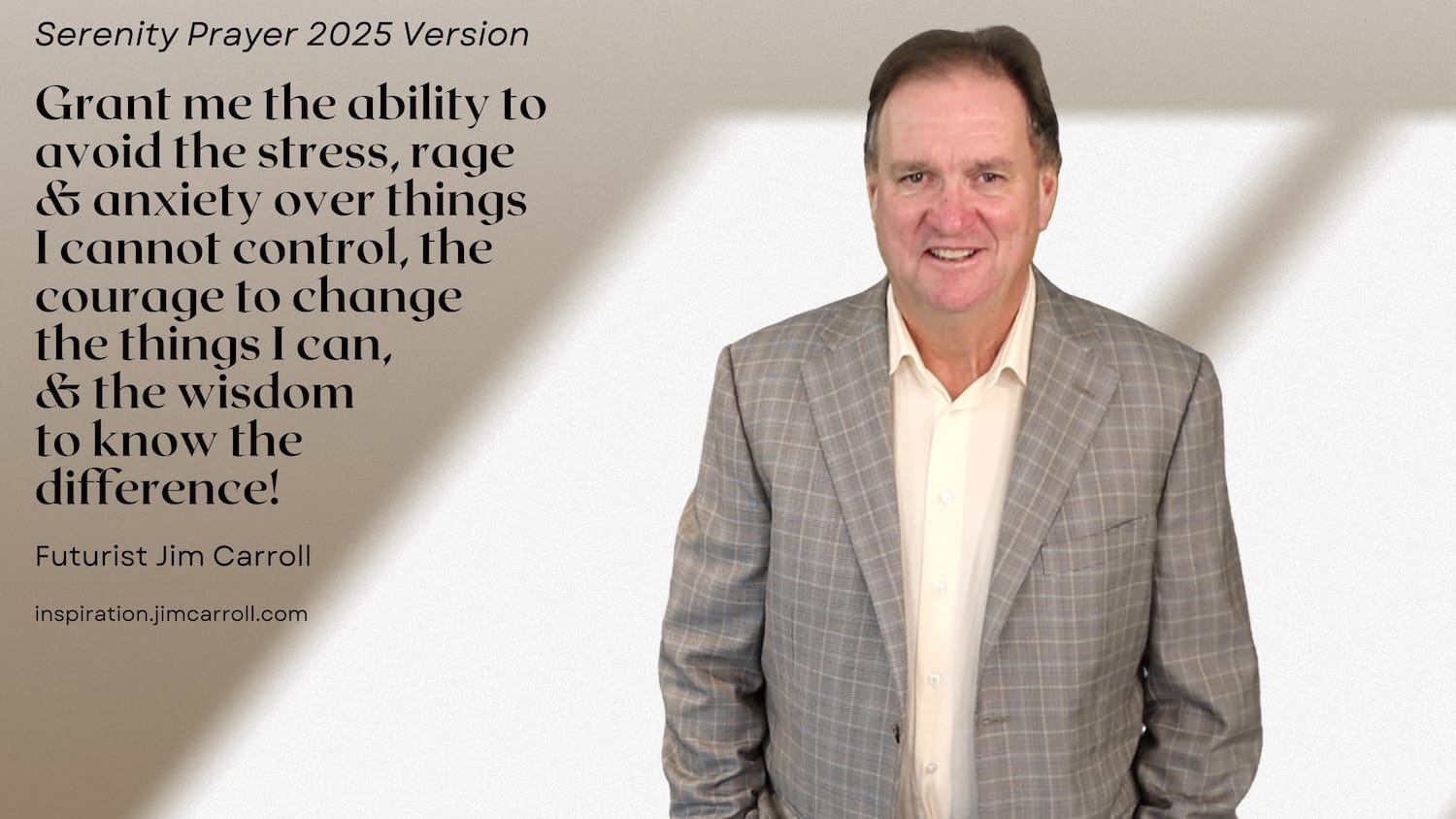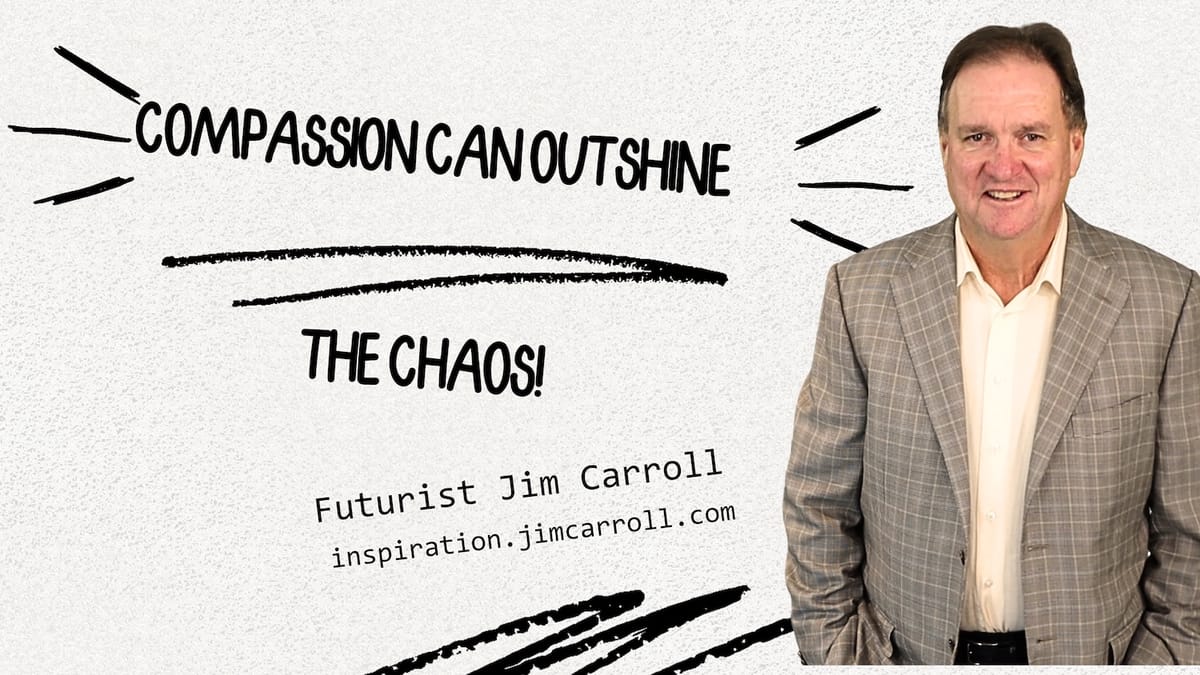"Compassion can outshine the chaos!" - Futurist Jim Carroll
Every day, I start with my image and quote, and then write my post. Today, I started with this image and quote:
“Grant me the ability to avoid the stress, rage & anxiety over things I cannot control, the courage to change the things I can, & the wisdom to know the difference!”

Then I noticed that what I wrote about - leadership empathy - had nothing to do with the original quote! So I changed it! I still like this version of the Serenity Prayer though!
Anyways ... to my original point. Have you noticed that a lot of people seem to be asking one another, pretty regularly: "How are you doing with all this stuff?" I need not explain the "stuff" - suffice it to say, there's volatility, upheaval, uncertainty, disruption, polarization, confusion, destabilization, turmoil, chaos - all of which is quite dystopian.
Aside from providing you with a comprehensive list of disquieting nouns, the fact is a lot of people are feeling discomfort, but are also expressing concern about those around them. At least the ones who have a soul left within their inner core.
Look, I'm from the old school that believes that human kindness is an important personal trait - perhaps one of the most important. I also know that in this current male-machismo-driven world of rage and revenge, there are simply some folks who will never understand that. I don't have any expectations that folks like that follow my writings here.
But maybe the rest of us can work on it a bit more. After all, it matters. Lots of folks might have been having a rough day, and a little expression of empathy can go a long way.
How can we do that? Here are the key elements of what is known as 'leadership empathy:'
- Understanding other perspectives - Recognize the feelings and thoughts of others to better respond to their needs
- Active listening - Be fully present, paying attention to both verbal and nonverbal communication
- Showing genuine care - Demonstrate sincere interest in the well-being and aspirations of others
- Perspective-taking - Step into others' shoes to experience situations from their viewpoint
- Emotional intelligence - Identify and manage your emotions while recognizing others' feelings
- Building trust - Create psychological safety where people feel supported
- Taking compassionate action - Move beyond understanding to actively help address concerns
- Effective communication - Connect with others in ways that make it feel safe to talk
- Adaptability - Quickly gauge the emotional atmosphere and adjust your approach
- Conflict resolution - Consider multiple perspectives to find common ground during disagreements
In times like these, empathy isn't just a nice-to-have leadership quality—it's essential. When people feel truly understood during challenging circumstances, their resilience multiplies. The organizations that thrive amid chaos are invariably those led by people who can connect authentically with others.
Are they out there? For sure. I recently spoke with a CEO who turned her struggling company around during the pandemic. Her secret? "I stopped trying to have all the answers and started listening as my business depended on it—because it did." Her teams felt seen during impossible circumstances, and they responded by bringing their best selves to work despite everything happening around them.
The beauty of empathy is that, unlike some leadership qualities that seem innate, empathy can be deliberately developed. Here's how:
- Practice active listening - Focus completely on the speaker, noting both words and body language. Put away your phone, stop formulating your response, and just be present.
- Cultivate perspective-taking - Regularly ask yourself "What would I think/feel in their position?" This mental habit builds your empathy muscles over time.
- Build emotional intelligence - Treat emotions as valuable data for better decision-making. Learn to name your feelings and recognize them in others.
- Show genuine interest - Check in regularly about both professional and personal challenges. Remember details about people's lives outside work.
- Validate feelings - Reflect on the emotions you observe before rushing to solutions. Sometimes people just need to be understood.
- Create safe spaces - Approach conversations with an open mind and without judgment. Let people know it's okay to be human.
- Take meaningful action - Move beyond understanding to help solve problems. Empathy without action can feel hollow.
- Monitor for burnout - Watch for signs of excessive stress and offer appropriate support before people reach their breaking point.
- Seek feedback - Regularly ask how you could improve your empathetic leadership. We all have blind spots.
- Model empathetic behavior - Consistently demonstrate empathy to build a supportive culture. What you do speaks louder than what you say.
In this world that seems to now reward toughness over tenderness, choosing empathy requires a certain type of courage. It means being willing to be affected by others' experiences rather than remaining detached. But here's what I've observed over many years: those who embrace empathy don't just build better organizations—they build better lives. They create ripples that extend far beyond the workplace, into families and communities that desperately need more understanding.
The next time someone asks, "How are you doing with all this stuff?" take it as an invitation to practice empathy yourself.
Futurist Jim Carroll would like to hear how you are doing. He might be able to offer up a comforting thought or two.

